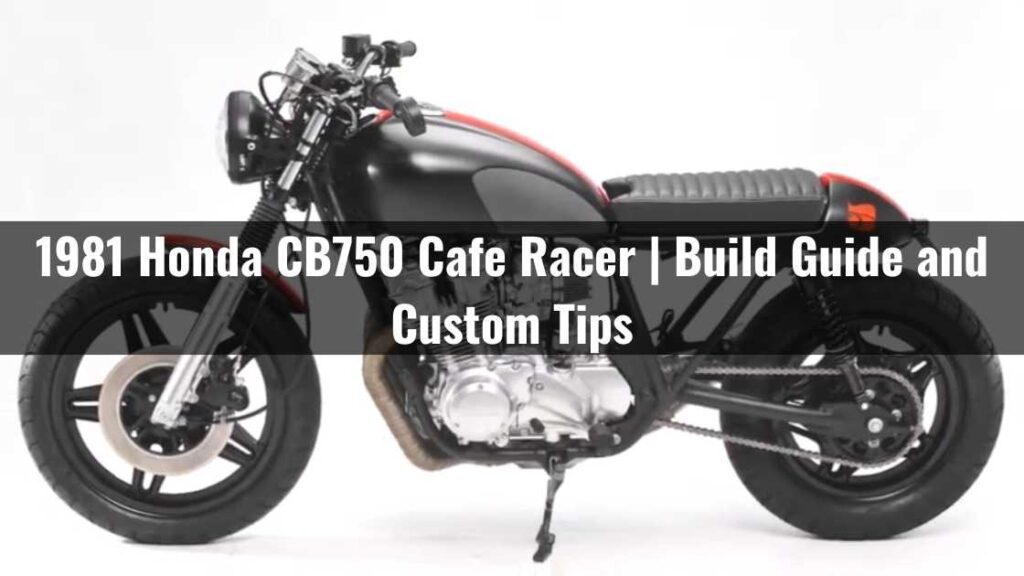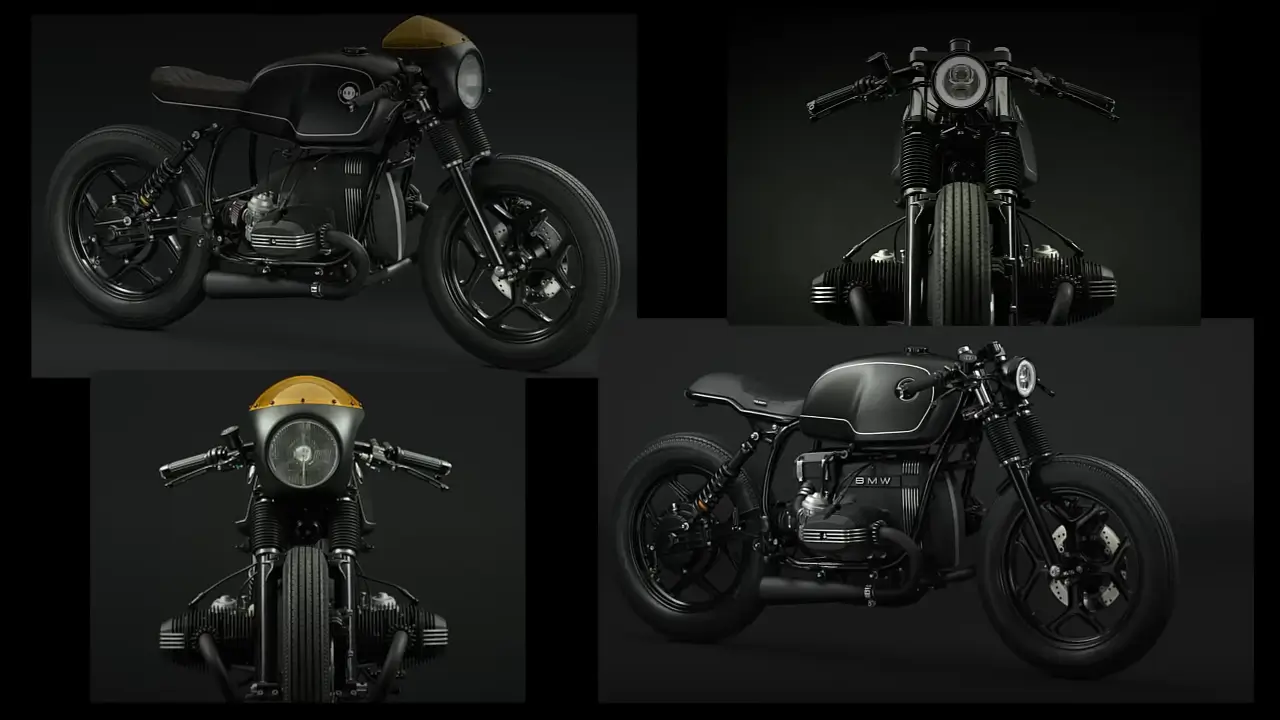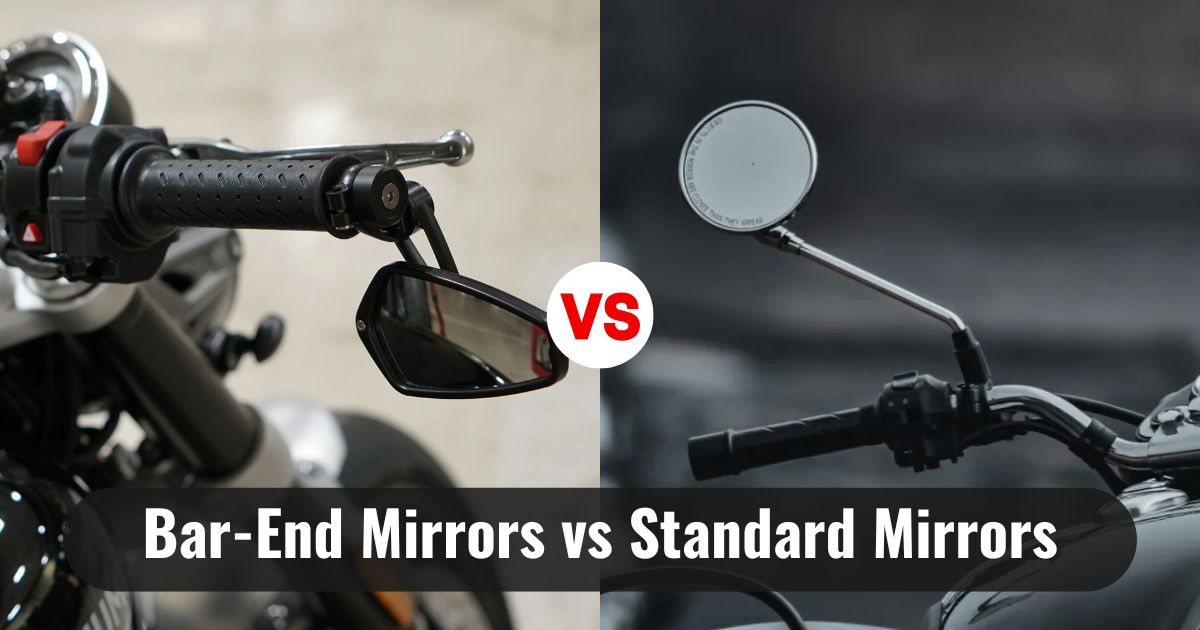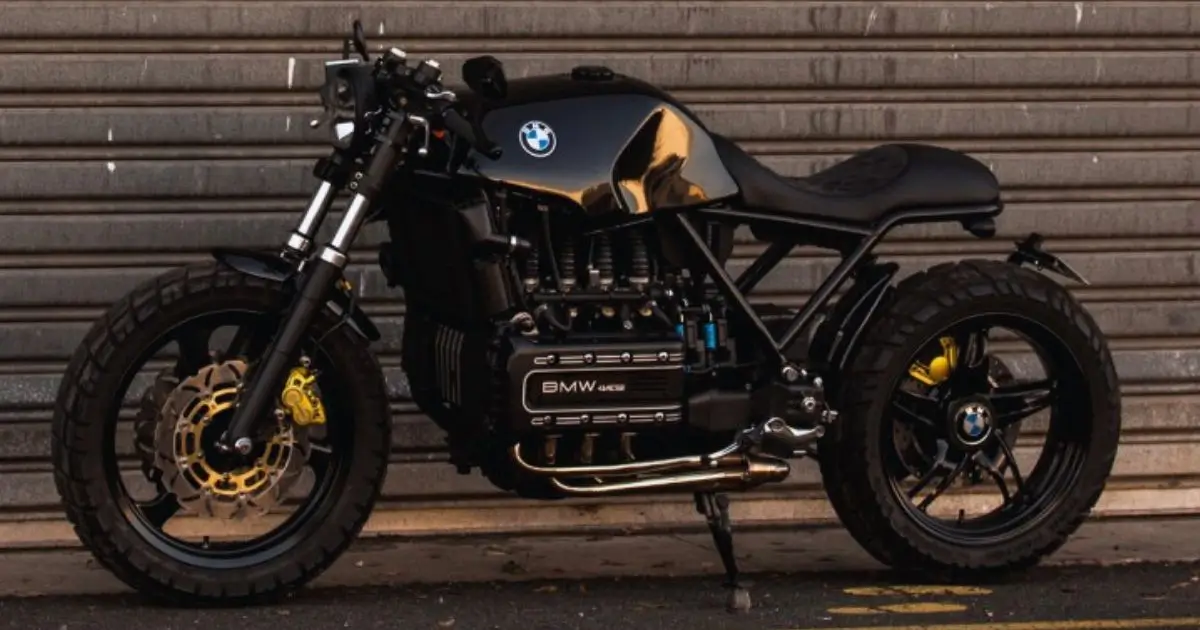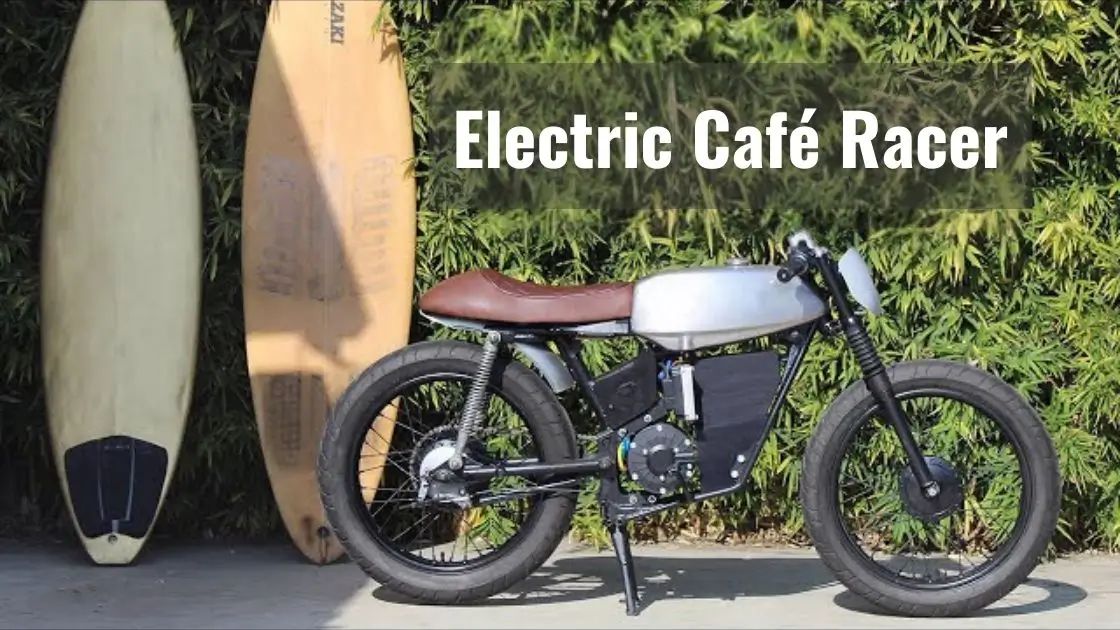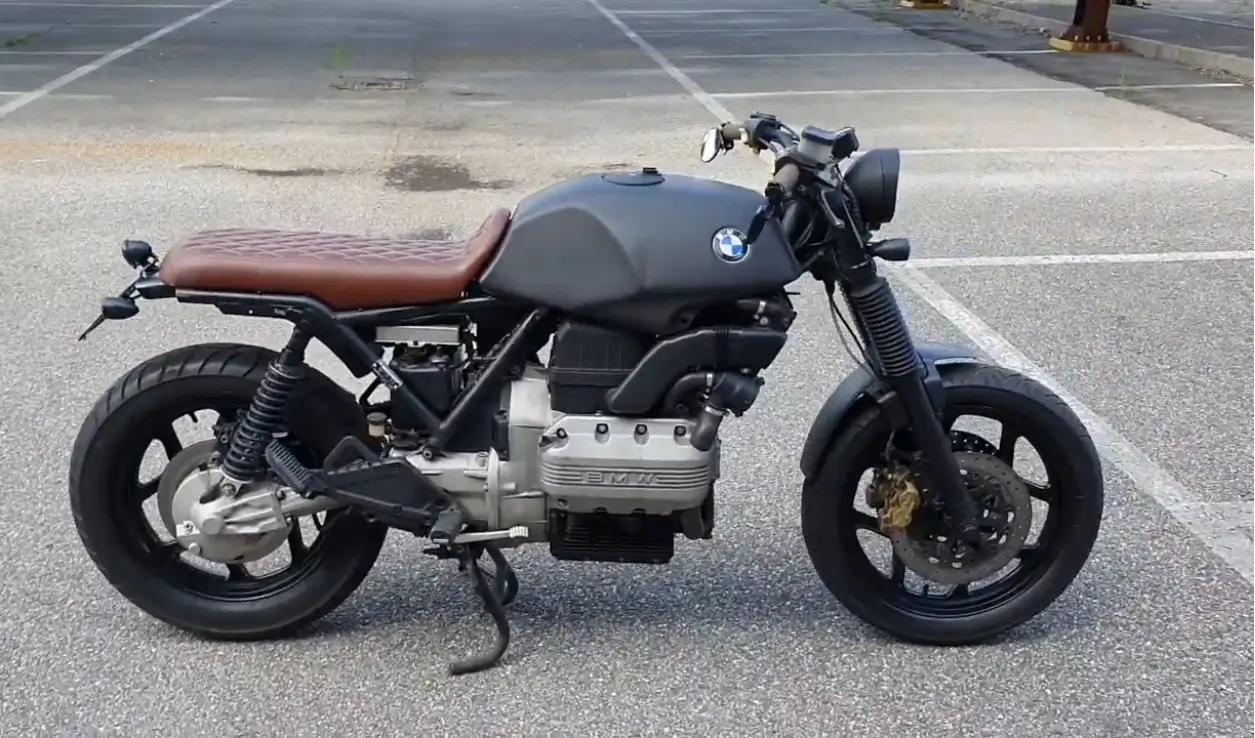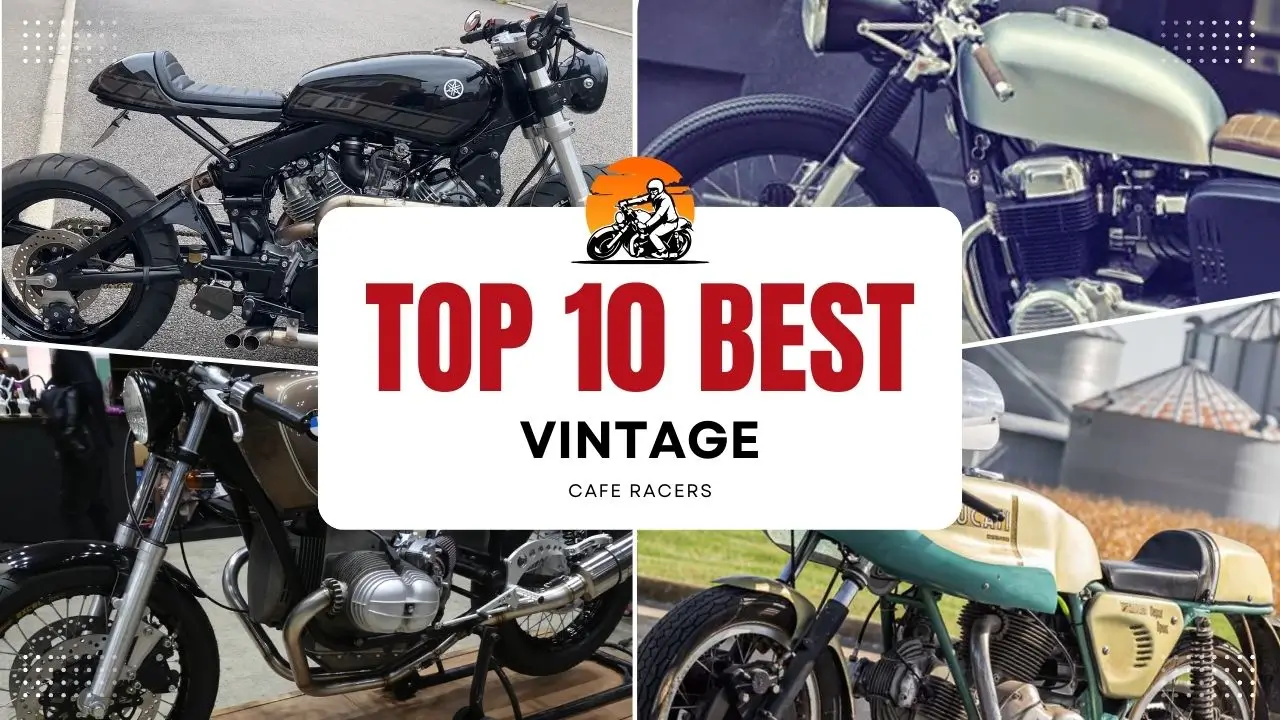Table of Contents
Toggle“When we talk about the 1981 Honda CB750, we are talking about a special motorcycle. It is not just any bike. It is one that many people choose when they want to build a 1981 Honda CB750 Cafe Racer. A cafe racer is a custom motorcycle made to look cool and go fast.
Now, let me explain why the 1981 Honda CB750 is great for this. Picture this: you have a bike that is strong, fast, and dependable. It has a powerful 4-cylinder engine. This bike is built to last. But it also gives people lots of options to make changes and improve it.
Why the 1981 Honda CB750 Stands Out?
You might wonder, “What makes the 1981 version special?” Honda made the CB750 in many years, right? But the 1981 CB750 is unique. It is part of the DOHC series. DOHC means Dual Overhead Camshaft, which makes the engine better and faster. This is exactly what you want for a cafe racer.
The 1981 CB750 is also a Super Sport model. This version is more about speed and control than the older models. So, if you start with a 1981 Honda CB750, you already have a strong engine and solid frame. The DOHC engine is why this model is a favorite for building cafe racers.
Engine Specifications of the 1981 CB750
Now, let’s talk about the technical details. The 1981 Honda CB750 has a 749cc DOHC engine with four cylinders. This engine is smooth and powerful. It doesn’t need much care to keep running, which is why people love it for custom bikes.
Here are some important details:
- Power: About 77 horsepower at 9,000 RPM.
- Torque: 44 lb-ft at 7,500 RPM.
- Transmission: 5-speed gearbox.
- Fuel system: Four 30mm Keihin carburetors.
The 4-cylinder engine made the CB750 famous. It is fast, smooth, and reliable. That’s why it’s great for building a custom bike that looks good and works well.
Design and Aesthetics of the 1981 Model
From a design view, the 1981 CB750 has a classic look. It’s perfect for turning into a cafe racer. The bike has a long gas tank, a slim seat, and simple bodywork. Many people love this clean style for cafe racers.
The original bike looks simple, but it’s easy to see why someone would want to change it. With its round headlight and flat seat, you can already picture how special it could look.
One cool thing about the 1981 CB750 is its dual front disc brakes and twin rear shocks. These not only make it look sporty but also improve how it handles. When you build a cafe racer, how the bike handles and stops is just as important as speed. This bike gives you a strong base for both.
How the 1981 Model Stands Out in the CB750 Line?
The Honda CB750 has been around since the late 1960s. But the 1981 model is part of the DOHC series, which started in the late 1970s. The earlier CB750s had a SOHC (Single Overhead Camshaft) engine. While those bikes are great too, the 1981 DOHC model has more power and is easier to modify.
For example, the DOHC engine makes it easier to add more power. If you want to make upgrades like a 4-into-1 exhaust or pod filters, this bike can handle it. That’s why many people think the 1981 model is one of the best for building a cafe racer.
Is the 1981 Honda CB750 Good for a Cafe Racer Build?
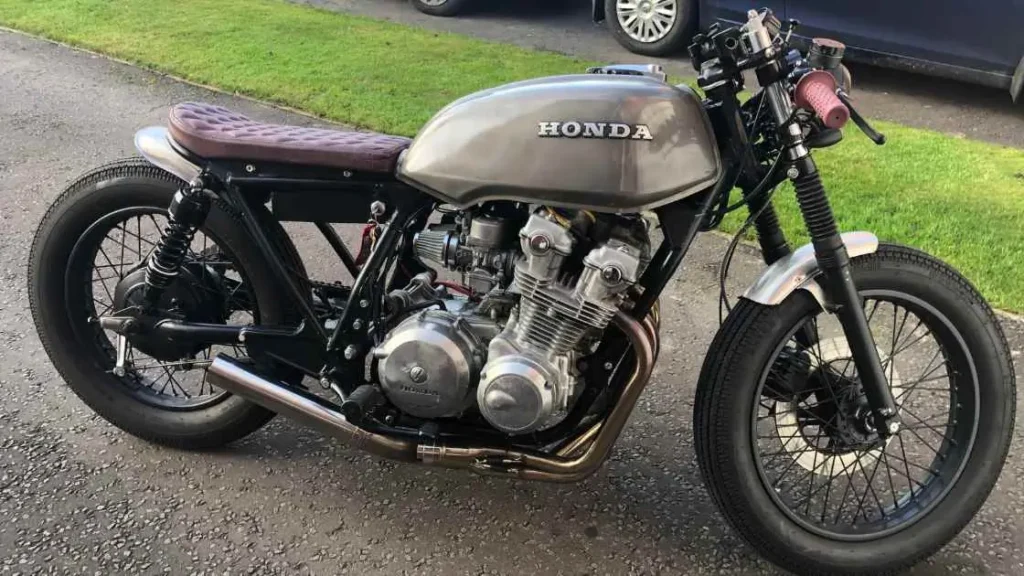
If you’re thinking about turning the 1981 Honda CB750 into a cafe racer, you’re making a good choice. The 1981 CB750 isn’t just another old motorcycle; it’s one of the best options for a cafe racer project. Why? The answer is in its engine, frame, and how easy it is to modify.
Many people, especially those new to building bikes, pick this model because it balances classic style with the ability to improve performance. In this section, I’ll show you why the 1981 Honda CB750 is a great starting point for your custom cafe racer.
Engine Potential for Performance Upgrades
One of the best things about the 1981 CB750 is its DOHC engine. This engine is 749cc, which gives it a lot of power for its age. The DOHC setup means the bike can rev higher and handle more upgrades than older models with SOHC engines. This is important if you want more speed or to add custom features like a 4-into-1 exhaust. This exhaust helps the engine run better and gives the bike a classic cafe racer sound.
Some common upgrades for the 1981 CB750 cafe racers are:
- Carburetor tuning or replacement: The stock carburetors work fine, but many people upgrade to pod filters or performance carburetors for better efficiency.
- Exhaust modifications: Adding a 4-into-1 exhaust improves airflow and gives the bike a simple, clean look—perfect for cafe racers.
- Ignition system upgrades: Many builders also update the ignition system for better reliability and performance. They often add a modern electronic ignition.
These upgrades make the bike faster, lighter, and more agile. This is exactly what you want in a cafe racer. So, if you enjoy working on engines, the 1981 CB750 offers many ways to boost performance.
Frame and Weight Considerations for Cafe Racer Builds
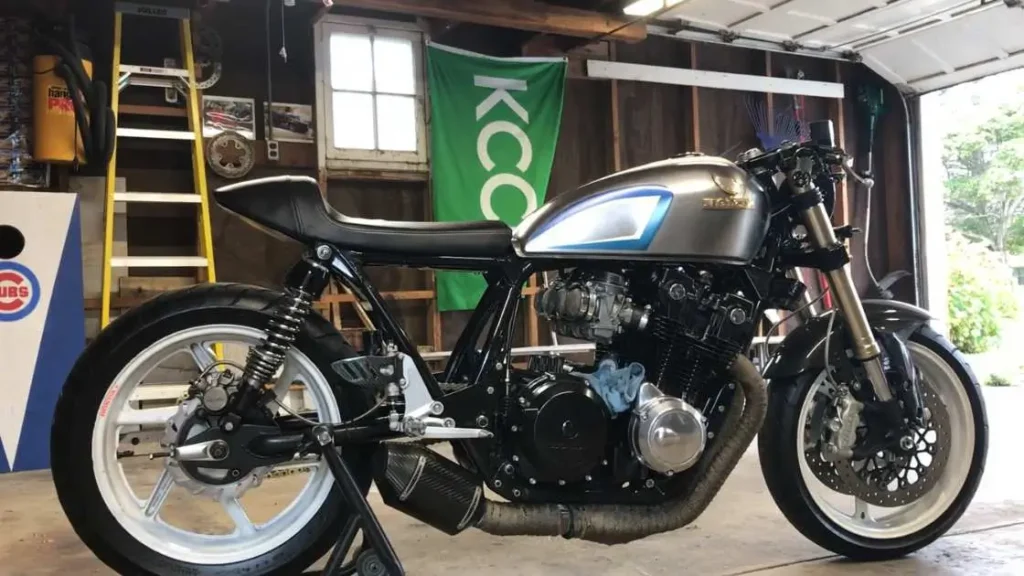
The 1981 CB750 has a strong and balanced frame, making it perfect for cafe racer conversions. The frame is strong enough to handle more power from engine upgrades. It is also flexible enough for custom changes, like modifying the rear loop to fit a cafe racer-style seat. That’s why many people use the 1981 CB750 as a base for their cafe racer projects.
While the 1981 CB750 isn’t the lightest bike, you can reduce some weight with smart modifications. For example:
- Replace the stock seat with a lighter cafe racer seat.
- Swap the original handlebars for clubman or clip-on handlebars for a sleeker look.
- Install smaller, lighter parts like a modern lithium-ion battery. It’s not only lighter but also more efficient.
The goal of a cafe racer is to make the bike as light and fast as possible. The 1981 CB750 gives you many ways to cut weight without losing the strength of the frame. This makes it a great choice for both new and experienced builders.
Customization Ideas Specific to the 1981 Honda CB750
Building a cafe racer is all about making your motorcycle unique. When customizing a 1981 Honda CB750, there are many options to explore. The bike’s strong frame and great engine provide a good base. Whether you want a simple, clean look or to improve performance, this section will give you ideas on how to turn your 1981 model into a one-of-a-kind cafe racer.
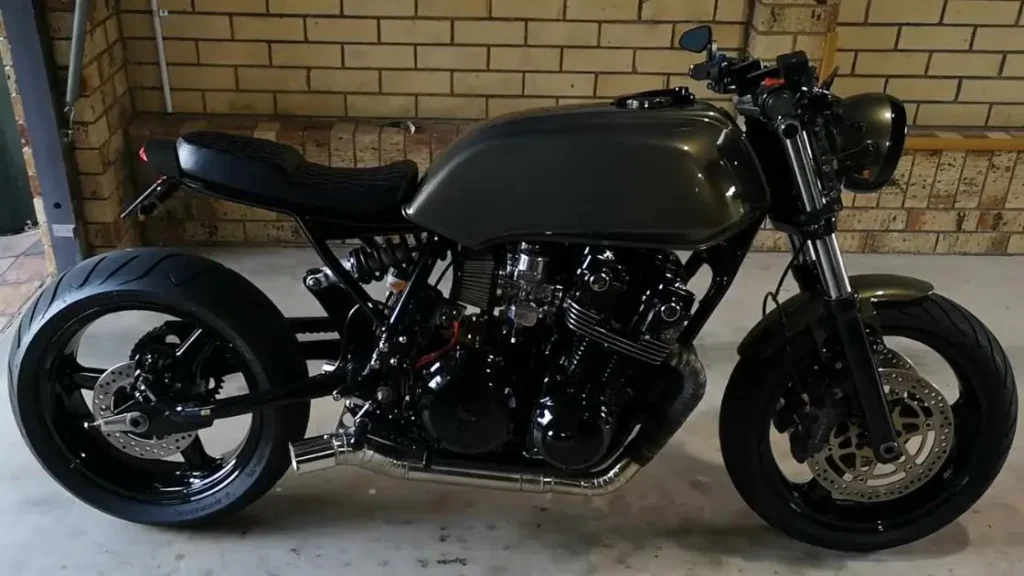
- 1981 Honda CB750 DOHC – Cafe Racer
Exhaust System Upgrades
One of the best upgrades you can make to the 1981 Honda CB750 is the exhaust system. Many builders choose a 4-into-1 exhaust. It improves performance and gives the bike a clean, bold look with that classic cafe racer sound.
Here’s why a 4-into-1 exhaust works well:
- Performance Boost: It allows better airflow, helping the engine run more smoothly. You’ll notice more power and a quicker throttle response.
- Weight Reduction: A 4-into-1 system is lighter than the stock exhaust. This helps with both speed and handling.
- Classic Style: The single-exit pipe matches the simple look of a cafe racer.
Many riders like stainless steel exhausts because they look great and resist rust. Brands like Mac Performance and Kerker are popular for these systems. The sound is loud and deep, perfect for making a strong statement both in looks and noise.
Seat and Tail Customizations
One key feature of any cafe racer is its seat and tail section. On the 1981 Honda CB750, the stock seat works but doesn’t match the cafe racer style. Most builders replace it with a custom cafe racer seat, often called a “bum stop” or “hump seat.”
Here are some options for customization:
- Cafe Racer Seat Kits: You can buy pre-made seat kits made for the CB750. These seats usually have the hump at the back, which is the classic cafe racer look.
- Custom-Made Seats: For a unique look, you can get a seat custom-made. Many builders choose leather or faux leather for the cover and add custom stitching.
- Frame Modifications: To fit a cafe racer seat, you may need to change the rear frame, called the rear loop. This makes room for the seat and gives the bike a cleaner look.
A slim seat and shortened rear frame help give the 1981 CB750 that low, sleek look cafe racers are known for.
Suspension Upgrades for the 1981 Model
Handling is important for a cafe racer, and upgrading the suspension on your 1981 Honda CB750 can make a big difference. The stock suspension is fine for regular rides, but if you plan to ride on twisty roads or want a smoother ride, upgrades are key.
Here’s what you can do:
- Rear Shocks: Replacing the stock rear shocks with aftermarket ones is common. Hagon or Progressive Suspension shocks are popular because they offer better control and comfort than the factory parts.
- Front Forks: For better handling, you can upgrade the front forks. Some builders replace the stock forks with GSXR forks, which give more precise handling and a modern feel.
- Fork Braces: Adding a fork brace can improve stability by reducing flex in the front end during sharp turns.
These upgrades make the bike feel more stable, which is important if you’re building a performance-focused cafe racer. Better handling means you can take faster turns and feel more confident on rough roads.
Electronics and Modern Add-ons
Even though the 1981 Honda CB750 is a vintage bike, you can still add modern upgrades to make it easier to use and more fun to ride. Many popular changes involve updating the bike’s electronics.
Here are some upgrades to think about:
- LED Headlights and Indicators: Many people replace the stock halogen headlight with a smaller, brighter LED. This not only looks better but also makes the bike more visible at night. Pair it with LED indicators for a simple, efficient look.
- Lithium-ion Battery: Swapping the lead-acid battery for a lithium-ion one is a common upgrade. These batteries are lighter and hold a charge longer, which is great for bikes that aren’t ridden every day.
- Simplified Wiring: The 1981 CB750 has a basic electrical system. However, many riders choose to install a Motogadget M-unit for cleaner, simpler wiring and to reduce electrical problems.
Upgrading the electronics makes the bike more reliable and easier to use. These changes also give the bike a cleaner look, perfect for a cafe racer build.
With these upgrades—new exhaust, seat, suspension, and electronics—you’re well on your way to building a stylish and fun-to-ride 1981 Honda CB750 cafe racer. Each modification improves the bike’s performance, comfort, and looks, giving you the full cafe racer experience.
Challenges and Considerations in Building a 1981 Honda CB750 Cafe Racer

Building a 1981 Honda CB750 Cafe Racer can be fun and rewarding. But, like any custom project, it has its own challenges. Whether this is your first cafe racer or you’ve built a few bikes before, there are some things about this model that can be tricky. In this section, we’ll look at common issues you might face when working on a 1981 CB750 and how to fix them.
Common Issues with the 1981 Honda CB750
When working on a motorcycle as old as the 1981 Honda CB750, you’ll face some challenges. The main issues usually involve mechanical wear, finding parts, and the electrical system. Let’s break these down:
- Mechanical Wear: After 40 years, most 1981 CB750s have been well-used. You may find worn parts such as:
- Gaskets: Old gaskets can be leaky or brittle. You will likely need to replace them when working on the engine or parts like the carburetor or exhaust.
- Carburetor Issues: The Keihin carburetors on the 1981 model often need regular tuning. If the bike has been sitting unused, cleaning or rebuilding the carburetors is needed to get it running smoothly again.
- Suspension: The stock suspension may feel soft or worn out. If you upgrade to a modern suspension system, you may need to modify the frame.
- Electrical System: The 1981 Honda CB750 uses a simple, old-style electrical system. Over time, wiring can fray or corrode. Many builders rewire the bike to ensure it works well. Modern wiring systems, like the Motogadget M-unit, can make this easier, but rewiring is still a time-consuming job.
Sourcing Parts for the 1981 CB750
When building a 1981 Honda CB750 Cafe Racer, finding the right parts is a big factor. The CB750 is popular, so parts are easier to find than for other old bikes. However, it can still be hard to find parts specific to the 1981 model.
- Aftermarket vs. Original Parts: Builders often choose between aftermarket parts or original Honda parts. Aftermarket parts are easier to find and may improve performance, especially for suspension and exhaust. But some builders prefer using original parts for authenticity.
- Exhaust and Engine Components: Finding a 4-into-1 exhaust system for the 1981 model can be tricky because not all systems fit the same. Make sure to check compatibility when buying aftermarket exhausts.
- Custom Fabrication: Sometimes, you may need to make or modify parts yourself. For example, if you’re changing the rear frame for a cafe racer seat, you might need to cut or weld parts to get the right fit. This adds time and complexity, especially if you’re new to metalwork.
Balancing Modern Add-ons While Retaining Classic Appeal
One challenge in building a 1981 Honda CB750 Cafe Racer is finding the right balance between modern upgrades and classic style. People love cafe racers for their vintage look, but modern parts can improve performance and comfort.
Here’s how you can balance both:
- Engine Upgrades: Modern carburetors, a Dynojet kit, or a new ignition system can boost performance while keeping the bike’s original look. Most of these upgrades are hidden, so they won’t change the vintage appearance.
- Brakes and Suspension: Modern brake calipers or GSXR front forks improve handling and safety. They may not be original, but they don’t change the bike’s look too much. Upgrading to steel-braided brake lines can also make braking better.
- LED Lighting: Swapping to LED headlights and indicators gives the bike a cleaner, more simple look while improving visibility and safety. Choose options that match the classic cafe racer style.
Examples of 1981 Honda CB750 Cafe Racers
Are you looking for ideas before starting your 1981 Honda CB750 Cafe Racer build? You’re not alone! Many builders have turned this classic bike into amazing cafe racers that look great and perform well. In this section, I’ll share a few standout builds to spark your creativity and help you see what’s possible with the 1981 CB750.
Featured Builds Based on the 1981 Model
1. Steel Bent Customs’ 1981 Honda CB750 Build
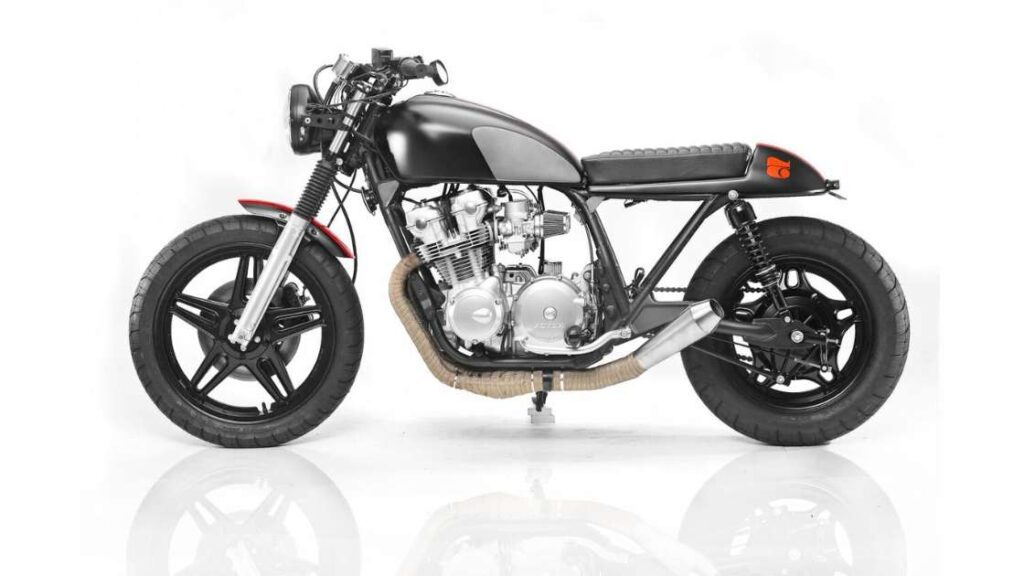
One standout build is the 1981 Honda CB750 by Steel Bent Customs. They focused on a minimalist design, staying true to the cafe racer style with clean lines and simple features. Key highlights include:
- A custom-made seat and rear cowl that match the bike’s frame, giving it a sleek cafe racer look.
- Clubman handlebars that lower the rider’s position, a classic feature of cafe racers.
- The stock engine was mostly kept the same but refreshed with new gaskets and an updated exhaust for a deep, powerful sound.
This bike balances performance and style, showing the potential of the 1981 CB750 as a cafe racer. The 4-into-1 exhaust adds both power and flair, while the modified frame and seat give it a more aggressive stance.
2. Nick’s 1981 CB750F Super Sport
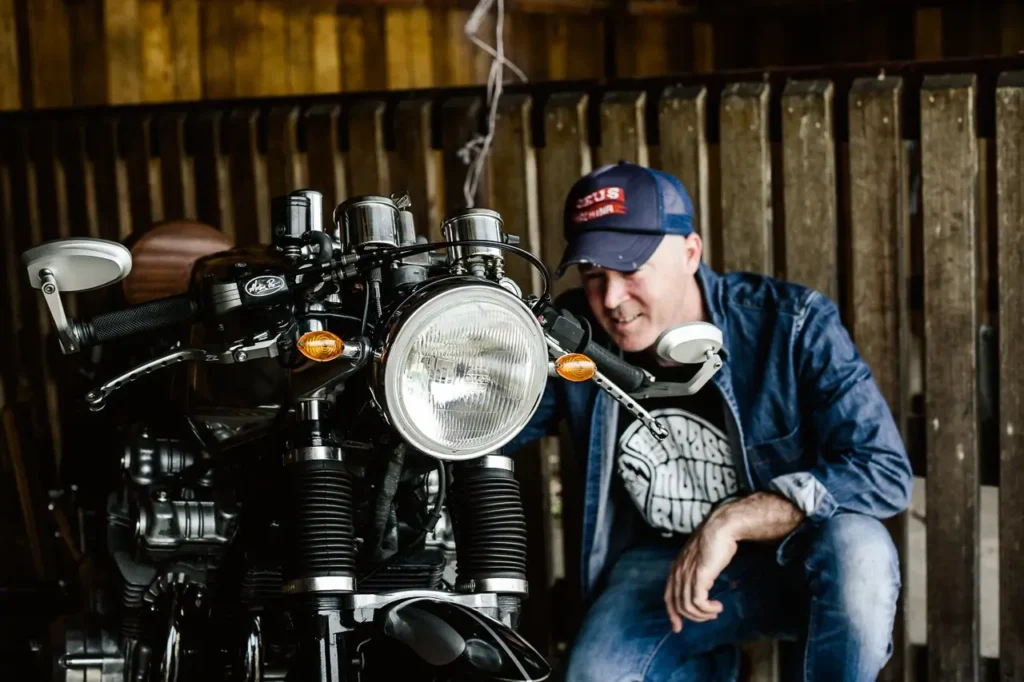
PHOTO CREDIT- throttleroll
Nick’s 1981 CB750F Super Sport is a great example of what’s possible with time and effort. After taking a break from bikes, Nick decided to turn his Super Sport into a cafe racer. He kept the classic cafe racer look but added some modern upgrades. Here are some key features:
- Engine upgrades: Nick increased the engine size to 836cc for more power and rebuilt the top end. This made the bike both fast and reliable.
- Custom frame modifications: To fit a new cafe racer seat, he modified the rear frame. This gave the bike a sleeker look.
- Brembo brake system: This upgrade greatly improved the bike’s stopping power, giving it modern handling to go with its vintage style.
Nick’s build took five years, but the result is a stunning and powerful cafe racer. It blends modern performance with classic looks.
How 1981-Specific Builds Differ from Other CB750 Cafe Racers?
Many CB750 cafe racers look similar, but builds based on the 1981 CB750 have unique features because of the DOHC engine and Super Sport frame. These features provide:
- Higher performance potential: The DOHC engine responds better to tuning and upgrades than the earlier SOHC engines. It’s ideal for riders who want a faster, more agile bike.
- Customization flexibility: The 1981 CB750 frame is strong enough for major changes. You can modify the rear loop for a cafe racer seat or adjust the stance to get the classic look without losing performance.
Another difference is the availability of parts. While parts for earlier CB750s can be hard to find, the 1981 model has more options for upgrades like suspension, brakes, and exhaust systems.
Each of these builds shows how you can transform the 1981 Honda CB750 into a unique cafe racer with both vintage style and modern performance. Whether you’re inspired by Steel Bent Customs’ minimalist design or Nick’s performance upgrades these builds prove that the 1981 CB750 is a great base for a cafe racer.
Tips for Maintaining a 1981 Honda CB750 Cafe Racer
After transforming your 1981 Honda CB750 into a cafe racer, the work isn’t over. Regular maintenance is key to keeping your bike in good condition. It will help ensure your bike stays reliable and fun to ride. The CB750 is known for its strong engine and dependable design, but, as an older model, it needs proper care. In this section, I’ll share important maintenance tips for your 1981 CB750 cafe racer.
Maintenance Tips for the 1981 Engine
The engine of your 1981 CB750 is the heart of the bike. Keeping it well-maintained is important for long life and top performance. Here are some key tips for maintaining your CB750’s engine:
- Regular Oil Changes: Oil changes are essential. For the 1981 CB750, change the oil every 3,000 miles or once a season. Use high-quality oil, like 10W-40, which works well in both hot and cold conditions.
- Check and Replace Spark Plugs: Spark plugs in older bikes like the CB750 can wear out. Check them every 6,000 miles. Look for wear signs like carbon build-up or corroded electrodes, and replace them if needed. Fresh plugs help the engine run smoothly and improve fuel efficiency.
- Tuning the Carburetors: The Keihin carburetors need regular tuning, especially if you’ve added pod filters or a 4-into-1 exhaust. Adjusting the air-fuel mixture helps the engine run better, and cleaning the carburetors prevents clogging. If the bike feels sluggish or doesn’t accelerate smoothly, it might be time for a tune-up.
- Chain and Sprocket Maintenance: The final drive chain and sprockets need regular care. Keep the chain clean and lubricated to prevent wear. Every few thousand miles, check for chain stretching or worn sprocket teeth. A worn chain can damage the sprockets and reduce the bike’s efficiency.
By keeping up with these simple tasks, your 1981 CB750 will stay in great condition and run like a dream for years to come.
Suspension and Handling Considerations for Older Models
If you’ve upgraded the suspension on your 1981 CB750 cafe racer, it’s important to maintain it for the best performance. The original suspension parts can wear out, so here are some tips to keep your bike handling well:
- Check the Rear Shocks: Regularly inspect the rear shocks. Even if you’ve upgraded to aftermarket shocks like Progressive Suspension or Hagon, check them for leaks or wear. If the bike feels bouncy or unstable, the shocks may need adjustment or replacement.
- Maintain the Front Forks: Check the front forks for oil leaks or signs of wear. If you’ve added modern forks like GSXR forks, make sure the seals and damping work properly. Change the fork oil regularly to keep them working smoothly.
- Tire Pressure and Condition: Good tires are essential for handling. Check that your tires, like Bridgestone Battlax, are inflated to the right pressure. Low pressure can make the bike feel sluggish, while over-inflated tires can make the ride harsh.
Proper suspension care not only makes your ride more comfortable but also improves handling and safety. This is especially important for cafe racers, which are designed to be fast and agile.
Electrical System Maintenance and Upgrades
The electrical system on your 1981 Honda CB750 needs regular care. Older bikes like the CB750 can have wiring issues if left unchecked. Here’s how to keep your electrical system in good shape:
- Battery Care: If you upgraded to a lithium-ion battery, it’s a good move for better reliability. Still, you need to keep it charged, especially if you don’t ride often. A lithium-ion battery holds a charge longer, but using a trickle charger helps keep it topped off when the bike is not in use.
- Wiring and Connections: Over time, wiring can become brittle or corroded. If you haven’t replaced the old wiring with a simpler system like the Motogadget M-unit, consider doing so. It’s easier to maintain and more reliable. Check all electrical connections regularly and clean any corroded terminals to avoid issues.
- Lighting: If you’ve installed LED headlights and indicators, they are mostly maintenance-free. But it’s still a good idea to check that all lights work before riding. Poor lighting is dangerous, especially at night.
Long-Term Care for a Custom Cafe Racer
Keeping your 1981 CB750 Cafe Racer in top shape requires both seasonal maintenance and regular checks. Here are some tips to keep your bike running smoothly for years:
- Seasonal Maintenance: Before storing your bike for the winter, give it a full service. Change the oil, lubricate the chain, and top off the battery. Store it in a dry place with a cover to protect it from dust and moisture.
- Tire Inspection: Tires can wear out over time, even if you don’t ride much. Check for cracks, flat spots, or other signs of wear. If you ride aggressively, consider upgrading to performance tires like Pirelli Sport Demons for better grip.
- Brake Fluid and Pads: Don’t forget about your brakes! Replace brake fluid every couple of years for the best performance. Also, check the brake pads and replace them if they’re worn down. Upgrades like Brembo brakes or steel-braided brake lines can improve stopping power.
Legal Considerations and Roadworthiness for Your 1981 Honda CB750 Cafe Racer
Building a custom 1981 Honda CB750 Cafe Racer is exciting, but you must make sure it is safe and legal for the road. Many places have specific rules about modified bikes, especially cafe racers. This section will guide you through the important legal and safety steps to follow before riding your bike on the street.
Making Your Custom Cafe Racer Street-Legal
When you customize a motorcycle, especially when modifying a classic like the 1981 CB750, there are a few things you need to ensure to meet local roadworthiness standards. Here are the most important legal factors to consider:
1. Lighting Requirements
One of the first things that authorities will look at is your lighting setup. Since cafe racers are all about a minimalist style, it’s common to swap out the stock lighting for smaller, sleeker options. However, you need to make sure that your lights meet legal requirements:
- Headlight: You’ll need a functioning headlight that meets brightness standards. If you’ve switched to an LED headlight, ensure it’s bright enough but not too dazzling for other road users.
- Indicators/Turn Signals: Many jurisdictions require front and rear turn signals. Make sure they’re bright enough and properly positioned. LED indicators are a popular choice because they’re low-profile and easy to install.
- Tail Light: A functioning tail light and brake light are essential. If you’ve changed the rear frame or added a custom seat, ensure the tail light is mounted in a visible position.
2. Mirrors
Even though many cafe racers lean towards minimalism, mirrors are generally a legal requirement. Your bike must have at least one rearview mirror (although some areas require two). If you’ve added bar-end mirrors, make sure they provide a clear view of what’s behind you.
3. Exhaust Noise and Emissions
One of the most exciting parts of a cafe racer build is upgrading the exhaust system, often with a 4-into-1 exhaust for that iconic sound. However, you need to ensure that your custom exhaust complies with noise and emissions regulations:
- Noise levels: Some areas have specific decibel limits for motorcycle exhausts. Check the regulations in your area to make sure your exhaust system doesn’t exceed the legal noise level.
- Emissions: Older bikes like the 1981 CB750 may not have been built with modern emissions standards in mind. In some areas, motorcycles are required to pass emissions tests. If your area requires an emissions test, ensure that your bike can pass, even with modifications.
4. License Plates and Holders
The position and visibility of your license plate are another important consideration. While many cafe racers have custom rear frames, you still need a visible and securely mounted license plate. In most places, the plate must be:
- Mounted horizontally: Some builders like to mount the license plate vertically or off to the side, but in many areas, it’s required to be horizontal and fully visible from the rear.
- Properly illuminated: A license plate light is often required, so make sure your plate is visible at night.
Safety Enhancements for Your 1981 Honda CB750 Cafe Racer
Besides meeting legal rules, it’s important to keep your bike safe for you and others on the road. Here are some key safety upgrades to consider:
- Brakes
Upgrading your brakes can make a big difference in safety. The old brakes on the 1981 CB750 may not be as strong as modern systems. Consider upgrading to:
- Brembo brakes or other performance brands for better stopping power.
- Steel-braided brake lines for a more responsive feel and longer-lasting performance.
- Tires
Good tires are key to both safety and handling. Make sure your tires have plenty of tread and no cracks. For better grip and handling, you might want to choose performance tires like Bridgestone Battlax or Pirelli Sport Demons. - Suspension
A well-maintained suspension improves comfort and keeps the tires firmly on the road. If you’ve upgraded to Hagon or Progressive Suspension, check them regularly for leaks or wear. - Reflectors
Reflectors are a simple but important safety feature. Some places require side and rear reflectors for better visibility. If you removed them for style, consider adding low-profile ones to follow the rules.
By following these safety and legal tips, you can keep your 1981 Honda CB750 Cafe Racer both safe and fun to ride. Focus on upgrades like brakes, tires, and suspension to make sure your custom bike meets the law and stays reliable on the road.
Conclusion
Building a 1981 Honda CB750 Cafe Racer is more than just fixing a bike. It’s about passion, creativity, and dedication. Choosing the 1981 CB750 gives you a bike with a strong history and lots of options for customization. The DOHC engine, solid frame, and classic design make it perfect for turning into a cafe racer. Whether you’re upgrading the engine, changing the frame, or adding a custom 4-into-1 exhaust, each change brings you closer to your dream bike.
Working on an older bike can be tough. Finding parts and keeping the carburetors and wiring in good shape takes time and patience. But overcoming these challenges makes finishing the bike even more rewarding. Every step, like adding modern upgrades such as LED lights or simplifying the wiring, allows you to make the bike your own.
Once your 1981 Honda CB750 Cafe Racer is finished, it’s more than just a motorcycle. It’s a sign of your hard work and passion. Riding a bike that you’ve built yourself feels special. You’ll feel a closer connection to the road, the bike, and the cafe racer community, knowing you’ve created something unique.
Disclaimer
This article is meant to share general information about building and maintaining a 1981 Honda CB750 Cafe Racer. The advice and tips provided are based on personal experiences and research, but it’s important to remember that every bike is different. Always make sure to check your local laws before making any modifications, and if you’re unsure about anything, it’s best to consult with a professional mechanic or expert.
Motorcycle customization can involve risks, so take all necessary safety precautions. We’re not responsible for any issues, damages, or injuries that may happen from following the advice in this article. You’re in control of your bike and the decisions you make about it, so please be cautious and responsible when working on or riding your motorcycle.
By using the information in this article, you agree to take full responsibility for any modifications you decide to make.
FAQs
Why is the 1981 Honda CB750 better for a cafe racer build?
The 1981 CB750 has a DOHC engine, which gives it better performance than older models. Its Super Sport frame is strong and easy to modify.
How do I care for the carburetors on my 1981 CB750?
Regular cleaning and tuning are important for older bikes. You need to keep the carburetors clean and synced, especially if you’ve added new parts like pod filters.
Do I need turn signals to ride a custom cafe racer legally?
Yes, most places require turn signals to be street-legal. You can use small LED lights to keep the bike’s clean look without breaking the law.
Should I upgrade the brakes on my 1981 CB750 cafe racer?
Yes, it’s a good idea. The stock brakes may not stop as well, especially if you’ve made the bike faster. Brembo brakes or steel-braided lines can help with safety.
What’s the best exhaust for a 1981 CB750 cafe racer?
A 4-into-1 exhaust is popular. It makes the bike lighter, improves airflow, and gives it that classic cafe racer sound. Just check local noise rules.
Is it hard to change the rear frame for a cafe racer seat?
Modifying the rear frame takes cutting and welding, but it’s possible with basic metalworking skills or by getting help from a shop.
Can I use my 1981 CB750 for long rides after turning it into a cafe racer?
Yes, but it might be less comfortable because cafe racers usually have a lower seat and less padding. You may need to adjust the seat for long trips.
What modern upgrades can I add without losing the classic look?
You can add LED lights, a Motogadget M-unit for better electronics, and new suspension. These will improve performance while keeping the vintage style.
Do I need to replace the battery with a lithium-ion one?
No, but it’s a smart choice. Lithium-ion batteries are lighter and last longer, which helps with weight and power, making your cafe racer even faster.
How do I balance modern upgrades with a classic cafe racer style?
Choose parts that boost performance, like modern suspension and brakes, without changing the bike’s look. These upgrades make the ride safer and smoother but keep the vintage feel.

